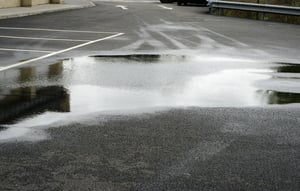 April showers might bring more than May showers if you (and your asphalt) aren't prepared.
April showers might bring more than May showers if you (and your asphalt) aren't prepared.
There’s a reason why experienced asphalt paving professionals recommend preventative asphalt maintenance. If you’ve taken the necessary steps to protect your pavement, a little April rain shouldn't cause any problems. However, if you haven’t completed general maintenance, small cracks, depressions and potholes could cause some serious Spring damage.
Problem: Water Weakens The Bond Between Asphalt Binder And Aggregates
If your pavement has cracks, it becomes vulnerable to the elements, specifically water. Given enough time, water can slowly erode your unprotected asphalt, accessing and weakening the supportive and structural layers of your pavement.
Wisconsin is known for having drastic weather fluctuations, which is not good if you have excess water in your parking lot. Standing water, which is often prevalent in the springtime, goes through the freeze/thaw cycle continually, which shrinks and expands water molecules. This process causes stripping, the process of debonding the aggregate and binder. When the bond between the aggregate and the binder deteriorates it weakens the pavement, making it more vulnerable to future damage. If the water gets under the sub-base it can even compromise the structural integrity of the pavement.
If left untreated, your small crack will only grow bigger and start to cause more damage. Before you know it your parking lot will be filled with alligator cracks, leaving you with an unsafe and unappealing pavement.
Solutions: Sealcoating, Surface Drainage & Pavement Maintenance
Sealcoating
You can protect your asphalt from water penetration with sealcoating. The sealcoating process adds a thin liquid layer over a paved surface to protect it from damage cause by UV ray, rain, snow and fluids from vehicles. Sealcoating is a great way to prevent cracks from forming in the first place and extends the life of your pavement.
It is typically recommended that you get an sealcoating application once every 3-5 years to protect your investment.
Drainage
Planning for proper water drainage is a very important step during the asphalt installation process. When constructing parking lots and driveways, contractors must plan on making the most out of grassy areas and inlets where water can be directed using slopes and asphalt curbing, which you can learn more about in this blog.
Special asphalt varieties, like porous asphalt, allow water to filter through layers, imitating the natural layers of earth that hold and clean water before allowing it to move into waterways. Full-depth porous asphalt pavements are so effective at stormwater management, they’re actually encouraged by the EPA as a best practice for green infrastructure.
Porous pavement allows water from rain or snow melt to drain through the pavement surface into a stone recharge bed, and filter back into the soil and groundwater below. Not only is it a great way to manage water drainage, it’s also a great way for your business to receive potential tax cuts.
Pavement Maintenance
Standing water and rainfall can’t exploit weaknesses in your pavement if there aren’t any. Small cracks are easier and more inexpensive to manage and repair than large cracks so it’s best to get them taken care of right away. If you would like more information on identifying potential problems download our free Spring Maintenance Checklist for repair tips and other helpful information.
Keep and eye on your pavement and watch out for the following:
- Cracking
- Surface slippage
- Potholes
- Divots
- Other imperfections
If you’re interested in talking more about asphalt solutions please contact us or feel free to reach out to our Oconomowoc office at 262-965-2121 or our Sun Prairie office at 608-249-79331.
Would you like to learn more about asphalt maintenance and protection?
Check our our free downloadable brochures.
The post Learn About The Effects of Spring Rain on Asphalt Parking Lots appeared first on https://www.wolfpaving.com/blog

No comments:
Post a Comment